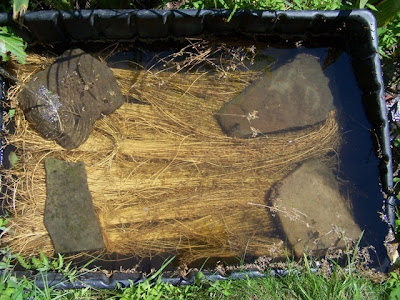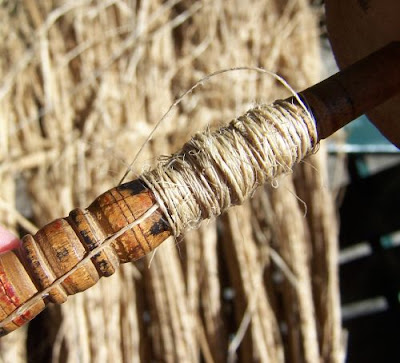Friday, August 30, 2013
the fawns
The doe finally brought her fawns by. I haven't seen them all summer. I've seen her, but not with her fawns. Last time I saw the fawns it was springtime and they were wearing their spots.
We've named this doe, "Beauty". She is sleek, and healthy, and well, beautiful.
Still no names for the fawns. Have to get to know them a little better.
Labels:
wildlife
Friday, August 02, 2013
granulobacterium pectinovorum or retting success

There is a bit of mystery that surrounds the process of wet retting flax. The procedure sounds simple enough. One need only submerge the dry flax stems in water and weigh them down so they are entirely covered for a period of time long enough for the bark to soften and allow the easy extraction of the fiber. The bark is macerated by active bacterium...specifically, granulobacterium pectinovorum...which dissolves the pectose present in the stems without injuring the bast fibers that will be spun to linen. There is science involved.

The mystery is "how long?" a period of time is required for the operation. How long will it take the microbes?? If it is under-retted the process is incomplete, the bacterium has not done the job and the retting has failed. If you over-rett, you have allowed the bacterium to go to far and it has ruined the flax. So, there is a decision to make about the timing...when is it "just right" to pull the flax from the pool?

It is an operation which for success calls for much judgment, vigilance, and precision. The determination of the exact point at which to stop the process demands much experience. So says Alfred Stewart Moore, author of .."LINEN" published by The Macmillan Company in 1922.
So, it isn't any wonder that I approach the retting pool with trepidation and proceed with caution. After raising the plants from seed and having a successful harvest, no one would want to risk it all and loose the fiber in the retting pool. I've lost linen in the pool in the past, and expect it will happen in the future. There is a learning curve. So, I rett small amounts at time, and take good notes.

I wait for the weather. When I see a good heat wave approaching on the weather map, I prepare. I had some dried flax in storage. This is flax that has been harvested, dried and rippled before storage. (Rippled meaning that the seed has been removed, so as not to attract hungry little critters).
My husbands cement tub is used for the pool. I position it in the streambed, where I channel a trickle of water to flow into the tub. Since there is a slope to the land, the pool has a deep end and a shallow end, and the water overflows on the deep side. The root ends should be positioned at the deep end of the pool. The flax wants to float, so rocks may be used to weigh the stems down. My flax was too long for the tub, so I had to bend the blossom end and tuck it under the rock.

In the slow flowing, soft, warm water, the microbes of putrefaction work on breaking down the pectins that trap the fiber. They convert the insoluble to soluble, and free the cellulose substance.
"The change is stated to be achieved by a special enzyme, pectokinase, which converts pectose successively into pectin and sugar, the bacteria afterwards fermenting the sugar with the production of hydrogen, carbon dioxide, and a little butyric acid. It may seem strange that this pectose is the same substance with gives apple jam its peculiar glutinous stiffness." ASM
I've been making raspberry jam, and have to add pectin in some form (fresh or powdered) in order for it to "gel". But out in my retting pool, I'm trying to remove pectin in order to retrieve my fiber. I find it ironic that adding and subtracting pectin can either create success or failure, depending upon ones objectives! You see, I've been thinking about pectin a lot.
There is no way of knowing exactly how many days it will take the microbes in my retting pool to do the job. There are estimates, anywhere from 3 days to 7 days. Water content, water temperatures, and the quality of the flax are all factors to consider. I test the stems daily after about 3 days...and pull the flax when I think it is ready. Then I hang it to dry for a few days. Then comes the moment of truth.

The shive or boon the broken fragments...some would consider waste, I will save this and use it this fall, for starting wood fires in my kitchen stove. The Longs, the Shorts and the Tow...I separate and set aside. I am relieved to see that the retting pool has yielded good results this time.

First we "completely remove all the pectin that binds the fibers together, and then the aim is to join them together again, by contact and twist inserted by the spinner".

I select a handspindle and fasten some of the new flax to the distaff...I cannot resist and must sample, just to see how it will look when it is spun. It really is a marvelous process..taking a little seed and raising it up..removing the tough outer shell to release the golden fibers so they may be spun...for me ...it is worth the work. Yes, Alfred Stewart Moore said it best...

"when you look at a dainty feather weight cambric handkerchief, you virtually see the soul of the flax plant"
Labels:
flax,
garden harvest,
spindle spinning
Subscribe to:
Posts (Atom)


